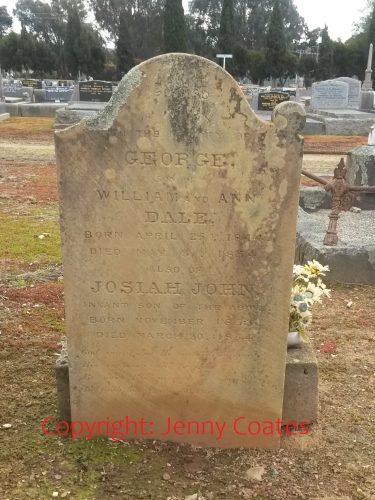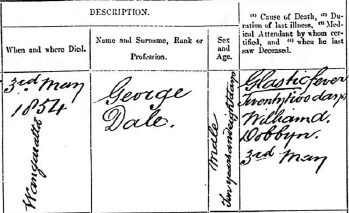This edition of Beyond the Headstone features the Dale family. The headstone is important as a rare surviving example from this period, but also because it signals quite clearly that the Tone Rd cemetery was in use in early to mid 1854. It is fairly certain that the cemetery was being used earlier than this, as the first burial ground now known as the Pioneer Cemetery in Faithfull Street had fallen out of favour by 1849, and the current cemetery was in use by 1852. However, surviving cemetery records only commence in 1862, and without many death certificates (more about that another time), or extant headstones, it is often impossible to tell who exactly was buried in that period between 1852 and 1862. The headstone is also useful to determine a date before when the Dale family came to Wangaratta, and gives an indication of the trauma suffered by families who endured multiple infant deaths.
Dale infant headstone, Wangaratta cemetery. Copyright: Conversations With Grandma
William Dale was born in 1819 in Bathurst, NSW and married Ann Beringer in 1840 at Parramatta where Ann had been born in 1820. Mrs Dale’s obituary in 1892 claimed that after marriage the couple moved to:
Reedy Creek Station, near Yass, then the property of Dale Brothers, where they remained for about ten years. In 1852, when the gold fever was at its height, Mr and Mrs Dale came to Victoria, roughing it on Back Creek, Bendigo, for about twelve months ; then coming to Snake Valley, or the Nine Mile as Stanley was then called. After leaving Stanley, where they remained about six months, Mrs Dale went back to Yass, rejoining her husband very soon afterwards when he had decided upon settling to live in Wangaratta, about the latter end of 1853.
By the end of 1853, Ann had borne seven children, and was to have another five in Wangaratta. William was a carpenter but he also turned his hand to several other occupations, and he was wealthy enough to buy two blocks of land in 1856 in Section 39 of Wangaratta township which had a frontage to Templeton St and backed on to the Ovens River. He bought several other blocks over the years and was considered fairly well off. This did not however, change the mortality rates that affected his family. Of the 12 children, six died before their parents – one as a young adult, George as a ten year old, and the remaining four as infants. We know about George and his younger brother Josiah John from the headstone.
The death registration for George has survived and shows that he died from gastric [typhoid] fever which had afflicted him for three weeks. Josiah John died from measles which was a common afflication. However, there are few records for the four remaining infants. I only know of them from the birth certificates of other children where the issue of William and Ann were summed up as e.g. “five living, four dead”, without names or ages. In one case I could match one of those un-named deceased infants to a burial of an un-named Dale child in December 1862. In order to reconstruct the Dale family it was necessary to use all possible sources – BDM certifcates (not just an index entry), cemetery records, obituaries, other newspaper reports, inquests, probate, land records, government and police gazettes.
Of note here is that even though Josiah died before George, the two deaths occurred within weeks of each other and William and Ann determined to place the first born child on the first position, rather than in order of date of death.







Flies were a huge pest everywhere there were horses, and many infants died from diseases carried by flies. It often makes me wonder if some of these infants were being bottle fed rather than breast fed. A distant relative of my husband’s once pointed out the high infant mortality in her family, and that is why the father of the family campaigned for clean water. However, my husband’s family lived right next door to that family, and none of their babies died from bad water. So was it the water or the care the babies were receiving?
Thanks for that fascinating bit of info Lenore. I had always associated typhoid with fleas, rats, mice, and in slum areas with shared toilet facilities, so this puts a new aspect on it.